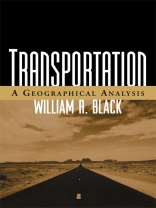This comprehensive text provides an authoritative introduction to transportation geography. With a primary focus on the United States, the volume also examines problems and trends in Europe and other parts of the developed world. Students gain a solid grasp of the history, definitions, and core concepts of the field, as well as models for analyzing transportation networks and flows between regions. Environmental, economic, and social issues in transportation planning and policy are addressed, and the uses of geographic information systems in transport (GIS-T) are discussed in detail. Written in a clear, straightforward style, the volume emphasizes real-world applications of the concepts discussed and identifies promising directions for future research. No advanced mathematical knowledge on the part of the reader is assumed.
Tabla de materias
Part I. Foundations 1. An Introduction to Transportation Geography 2. A History of Transportation 3. Current Transport Systems and Trends Part II. Network Analysis 4. Basic Elements of Transport Networks: Nodes and Links 5. Measurement of Transportation Networks 6. The Location of Transportation Routes and Links Part III. Flow Analysis 7. Trade and Commodity Flows 8. Methods of Flow Analysis 9. The Prediction Problem of Flow Generation10. Spatial Interaction and the Gravity Model11. Spatial Choices: Destinations, Modes, and Routes Part IV. Policy, Plans, and Impacts12. Transport Policy13. Transport Planning: Rationale and Process14. Transport Impact Analysis15. Transportation¿s Impact on the Environment16. Transportation, the Economy, and Economic Development Part V. Geographic Information Systems in Transport (GIS-T)17. GIS-T: An Introduction Part VI. Current Issues and Problems18. Societal Trends and Their Impact on Transport19. Congestion20. Sustainable Transport and Potential Mobility Part VII. The Future21. Transportation and Transportation Geography References
Sobre el autor
William R. Black is Professor of Geography and Public and Environmental Affairs at Indiana University-Bloomington. During his career at Indiana University he has directed 16 transportation research projects for state and federal transportation agencies and published more than 200 research papers and reports. He served on the activation task force that created the Consolidated Rail Corporation in the 1970s and was the first director of the Indiana Department of Transportation in 1980. He has served as chair of the Transportation Specialty Group of the Association of American Geographers (AAG) and as North American Associate Editor of the Journal of Transport Geography. He is the recipient of the AAG’s 1995 Ullman Award for contributions to transportation geography. In 2000 he presented the Fleming lecture in transport geography at the annual AAG meeting. He is active in the Transportation Research Board (TRB) of the National Research Council where he served as Chairman of the Committee on Social and Economic Factors in Transportation, and continues to serve as a member of several other committees and project panels. He received a Distinguished Service Award from the TRB in 2002. He is currently coordinator of STAR, a sustainable transport analysis and research thematic network funded by the National Science Foundation.












